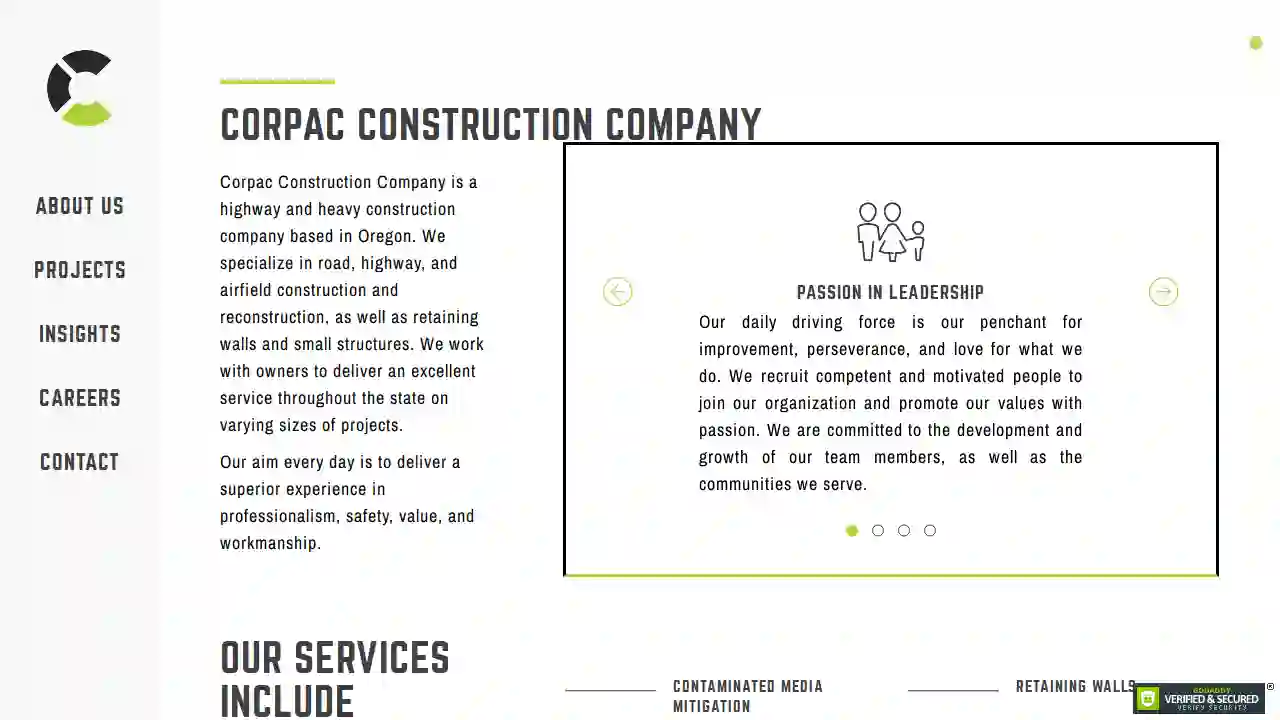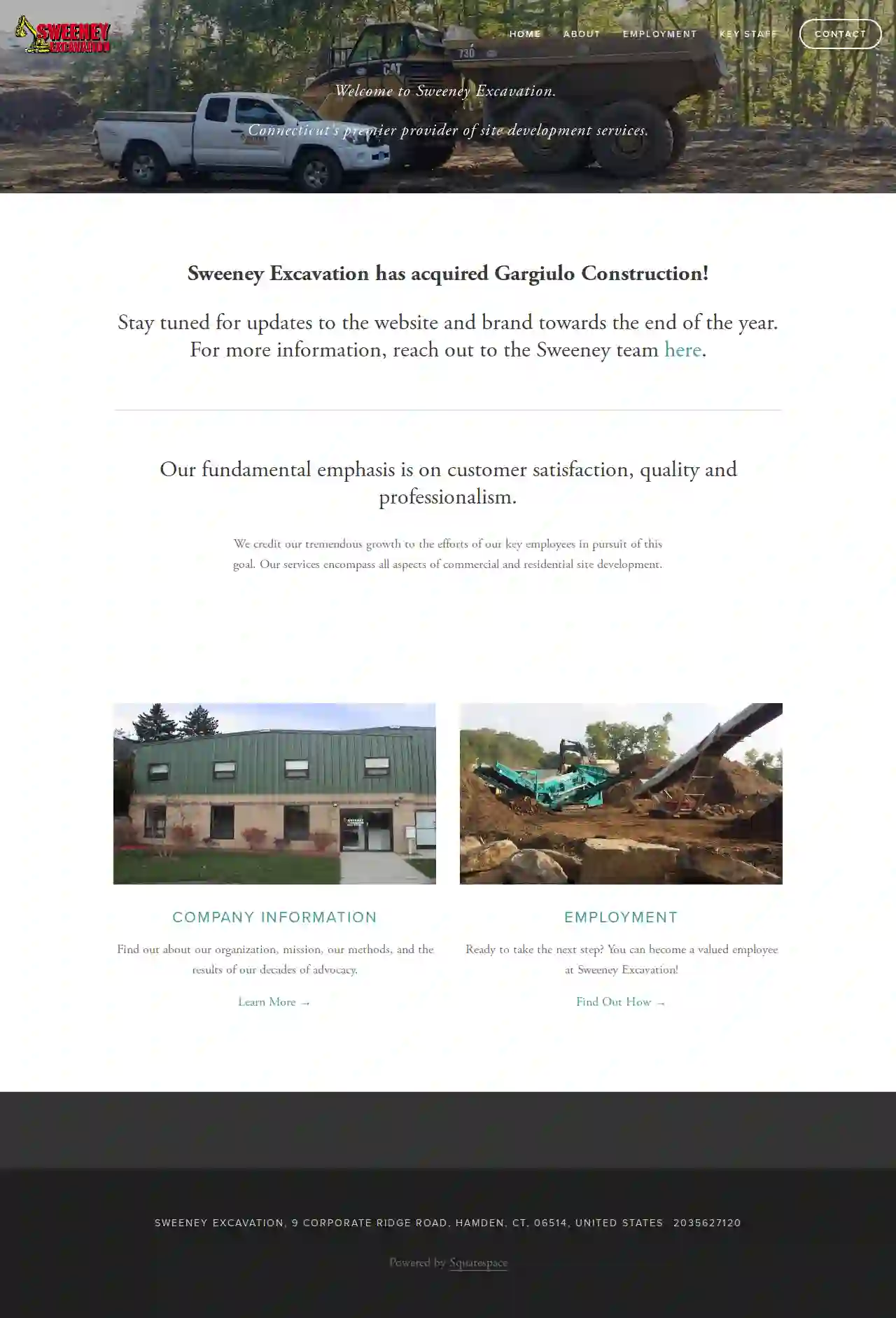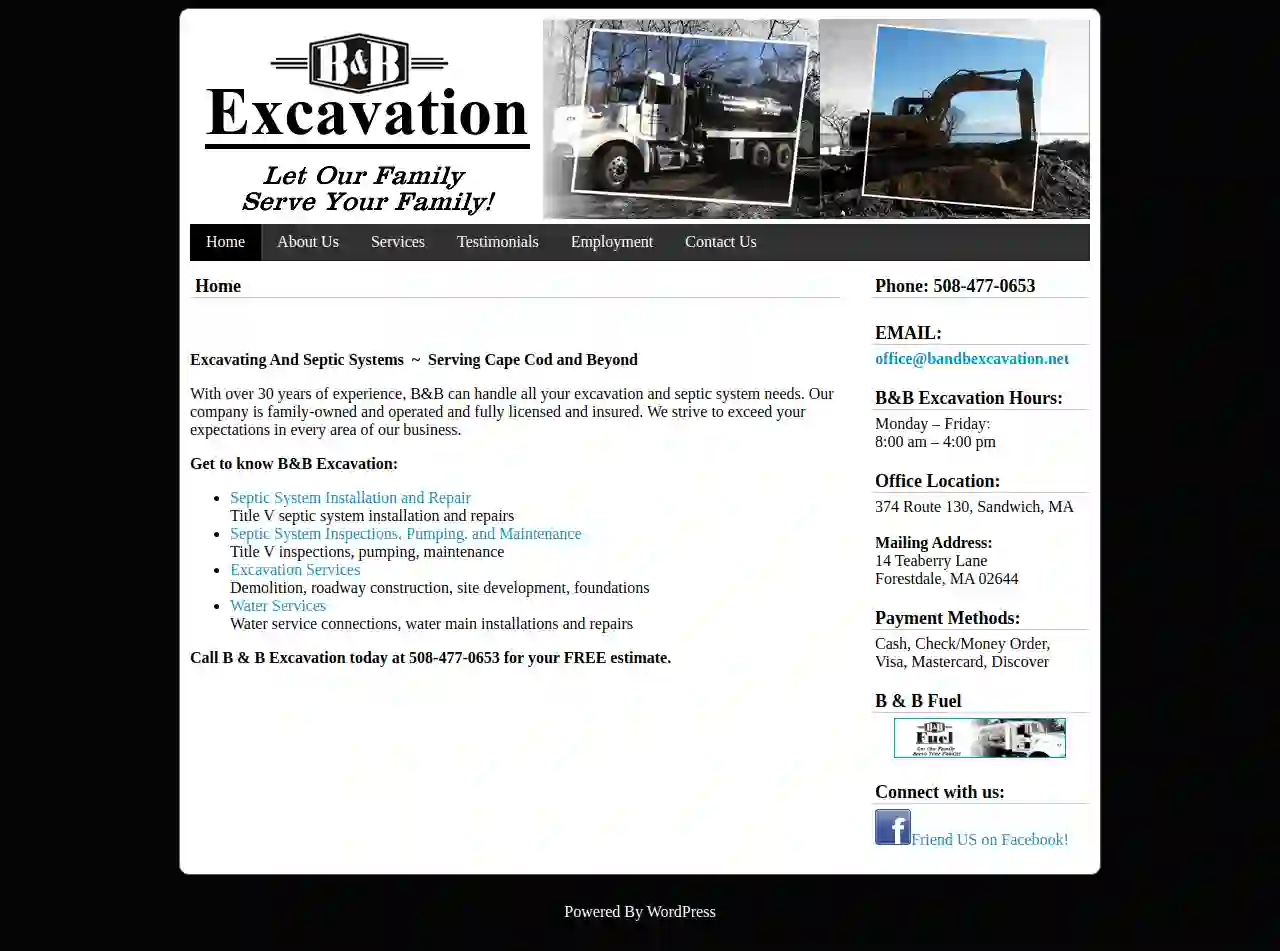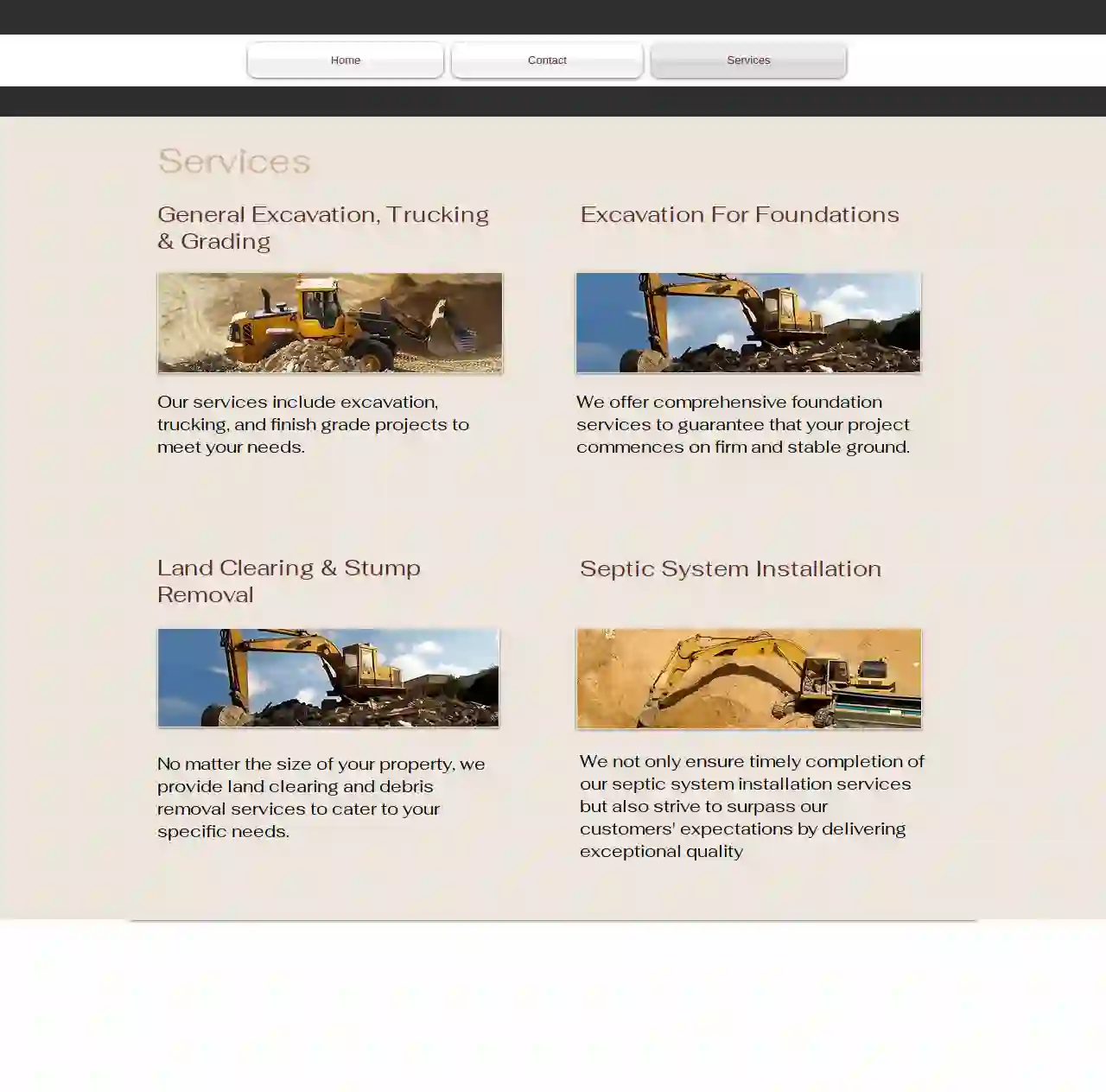Excavation Contractors Newton
Find Trenching Services in Newton
Receive 3 FREE Excavation Contractor quotes for your project today! Compare profiles, reviews, accreditations, portfolio, etc... and choose the best offer.

Corpac Construction Company
1.67 reviewsPortland, USCorpac Construction Company Corpac Construction Company is a highway and heavy construction company based in Oregon. We specialize in road, highway, and airfield construction and reconstruction, as well as retaining walls and small structures. We work with owners to deliver an excellent service throughout the state on varying sizes of projects. Our aim every day is to deliver a superior experience in professionalism, safety, value, and workmanship. PASSION IN LEADERSHIP Our daily driving force is our penchant for improvement, perseverance, and love for what we do. We recruit competent and motivated people to join our organization and promote our values with passion. We are committed to the development and growth of our team members, as well as the communities we serve. VALUES We believe in a team-integrated, partnered approach to projects with our clients, personnel, and trade partners. We believe in the development of technologies, processes, and methodologies informed by data and research-proven results. We believe teams rich in diversity and inclusion are the strongest. We believe leadership that supports work to life balance, a learning environment, and recognition drive productivity. SAFETY FIRST We are committed to sustaining a culture of safety by providing the necessary personnel, tools, training, and support to all of our team members. WORK HARD? SO DO WE. Corpac seeks individuals that are hardworking, dependable, and team-oriented for our main office and job sites throughout the state of Oregon. Corpac is a team of strong individuals who thrive working collectively together to get the job done at a high level of execution. We pride ourselves in our core values that we incorporate into our work every day. CARRYING ON A TRADITION IN HEAVY CIVIL CONSTRUCTION OVER FORTY YEARS LONG AND COUNTING Our heritage in the construction industry is one we are driven to honor every day. It is one of the elemental forces behind our leadership. There is pride in our craft at every level of the organization and gratitude for the role we play in the Pacific Northwest marketplace and American economy. Old school ethics; new-school vision. OLD SCHOOL VALUES; NEW SCHOOL VISION Corpac is built on the foundation of timeless business ethics: integrity, reliability, trust, and respect. Our modern approach is to build on this foundation and continually improve through research, education, innovation, and vision. Respect is the cornerstone of our relationships.
- Services
- Why Us?
- Accreditations
- Gallery
Get Quote
Extreme Excavating Inc
4.710 reviews241 N Grant Street, Canby, 97013, USOREGON’S PREMIER EXCAVATION CONTRACTOR NOW PART OF THE CHARGE FAMILY OF BRANDS Extreme Excavating Company (EXC) specializes in underground utilities, commercial excavation, site prep, and other commercial contracting services. We provide complete solutions for utility providers in the most challenging environments, with more than 20 years of experience in the Pacific Northwest. Marquam Radial Feeder System The Marquam Radial scope expanded the Marquam substation to deliver service to Portland's South Waterfront, as well as accommodate future radial feeder getaways. Read More Quality Service and Craftsmanship EXC is committed to upholding high standards and establishing mutually beneficial contractor/client relationships. You can rely on us during all aspects of the project to deliver quality work on time and on budget. No exceptions! Learn about EXC Trusted and Knowledgeable EXC strives to be your go-to commercial contractor. It is our mission to provide the service possible and to be timely, efficient and knowledgeable. Your satisfaction is ours, and we will work tirelessly until it’s right. Learn about our capabilities Related Projects Lincoln High School, Portland, Oregon Pearl Apartments, Portland, Oregon
- Services
- Why Us?
- Gallery
Get Quote
Butts Bros Excavation LLC
51 reviewsNew Milford, 06776, USExcellence In Excavation When the people in our community need the expertise and professional oversight of an excavation contractor, they know to contact Butts Bros Excavation LLC. Whether you need someone to clear the land on a worksite, dig out a pond, or excavate for a home foundation, we can help you. Homeowners and skilled builders alike look to us for all their excavating needs—and the reasons why are obvious. Whether you’re most concerned with quick turnarounds, reasonable rates, or excellent results, you will surely love our approach to excavation. Book our services today for your upcoming project. Call (203) 994-5264 to schedule your consultation. Making Excavation Look Easy We are high-demand excavation contractors. Not a day goes by where we are not doing earthwork, digging trenches, or aiding the development of a new property. Over the years, we have come to understand the finer points of excavation better than the rest. We Serve the Customer We work in accordance with the standards of our trade, make no mistake. That said, we also believe in serving the customer every step of the way. We will listen to your requests, answer your questions, and address any concerns you might have. In the end, you get quality results and a customer experience like no other. Ready for Every Excavation Project Do you want to dig out a pond in the backyard of your home? Are you looking to clear a piece of property of large rocks and other masses? We can help you. Between our unparalleled expertise and vast storehouse of equipment, we can undertake just about any excavation project. Some of the services we offer include: Basement excavation Pond digging and filling Site clearing Trenches and troughs Foundation digging Grading And more Aiding Residential and Commercial Excavation Projects Since our company’s inception, we have had the opportunity to assist in projects of all varieties, from home building to commercial landscaping and everything in between. We tackle projects of all sizes—and what’s more, we treat every project with the seriousness it deserves. Would you like to learn a little more about us? Call our offices today. Your Excavation Is Always a Success with Us There are a lot of moving parts, crew members, and ongoing projects on any given worksite.
- Services
- Why Us?
- Gallery
Get Quote
Luciano's Excavation Inc
56 reviews41 Taunton Green Suite 102, Taunton, 02780, USABOUT US Lucianos Excavation is a family owned and operated business. We provide experience and guidance throughout the construction process. With Cost Effective Solutions, we apply best business practices to complete and meet your needs. Luciano Ribeiro came over to America in 1985, from the Cape Verde islands. After ten years of building boats for Boston Whaler, he decided he needed a new career and turned to construction in 1995. He started from the ground up, as a laborer, doing what ever he could to soak up all the knowledge around him. After a year of hard work and staying late off the clock to learn how to move the equipment, they finally gave him a chance to operate machinery. Starting off in the loader gave him a chance to get the feel for heavy equipment, after 3 years of gaining experience he was finally able to get into the excavator. 25 years later he has now become one of the best excavator operators in New England, and his quality of work never goes unnoticed! From dredging ponds to putting in revetments, there is nothing he is unable to do in an excavator!
- Services
- Why Us?
- Gallery
Get Quote
Sweeney Excavation Inc
53 reviews9 Corporate Ridge RD, Hamden, 06514, USWelcome to Sweeney Excavation. Connecticut's premier provider of site development services. Sweeney Excavation has acquired Gargiulo Construction! Stay tuned for updates to the website and brand towards the end of the year. For more information, reach out to the Sweeney team here. Our fundamental emphasis is on customer satisfaction, quality and professionalism. We credit our tremendous growth to the efforts of our key employees in pursuit of this goal. Our services encompass all aspects of commercial and residential site development. Learn More → Find Out How →
- Services
- Why Us?
- Gallery
Get Quote
Rotex Excavation
4.58 reviewsVeneta, OR, USClearing the Way Since 1997 Work With an Expert Turn to Our Team of Excavating Professionals for Turnkey Services in Veneta, OR, the Willamette Valley, and All of Western Oregon At Rotex Excavation, we take pride in having over 27 years of experience as construction, excavating, and land management contractors. Whenever customers seek our help, we go the extra mile to ensure that they receive the professional excavating and land management service they are looking for. We understand your project is unique and aim to provide the best possible service for your needs. Whether you need excavation, land clearing, forestry mulching, or septic tank installation in the Lower Willamette Valley and surrounding areas, we can help. Included in our services are the following: Forestry Mulching Land Maintenance and Management Fire Fuel Reduction Defensible Space Management Invasive Species Management Storm Damage and Disaster Cleanup Fence Line Clearing Brush Hogging Land Clearing Tree and Stump Removal Field Mowing Site Prep Utilities Septic Systems Tree Removal Drainage Services Brush Clearing Fence Line Clearing Driveway Clearing Choose a Reliable Excavation and Land Management Contractor Customer Satisfaction Is Our Priority Professional excavation and land management services are a must-have for any construction project. You can rely on Rotex Excavation to get the job done right. As a trusted excavation and land management company, you can depend on our trained professionals to use the machinery to complete your project efficiently. You can always trust our experts to work efficiently and productively, producing results at the highest quality standards. Every project is different, with varying budget requirements With this in mind, Rotex Excavation will make every effort to accommodate the customer’s needs and project goals while working hard to deliver the most complete project within the customer’s budget.
- Services
- Why Us?
- Testimonials
- Gallery
Get Quote
B & B Excavation
4.826 reviews374 Route 130, Sandwich, 02644, USExcavating And Septic Systems ~ Serving Cape Cod and Beyond With over 30 years of experience, B&B can handle all your excavation and septic system needs. Our company is family-owned and operated and fully licensed and insured. We strive to exceed your expectations in every area of our business. Get to know B&B Excavation:
- Services
- Why Us?
- Gallery
Get Quote
Coastline Excavation Plymouth, Ma
51 reviewsPlymouth, USCoastline Excavation: Your Trusted Partner for Excavation, Trucking, and Grading Coastline Excavation is a reputable company dedicated to providing high-quality excavation, trucking, and grading services to meet your project needs. We understand the importance of a solid foundation for any construction project, and our team of experienced professionals is committed to delivering exceptional results. From initial site preparation to final grading, we handle every aspect of your project with precision and care. Our modern equipment and skilled operators ensure efficient and timely completion, minimizing disruption to your schedule. We take pride in our commitment to customer satisfaction. Our team is dedicated to providing clear communication, competitive pricing, and a personalized approach to every project. We work closely with our clients to understand their specific requirements and ensure their complete satisfaction.
- Services
- Why Us?
- Gallery
Get Quote
Fleury Excavation LLC
4.916 reviewsWaterbury, USWelcome to Fleury Excavation At Fleury Excavation LLC, we specialize in providing top-quality excavation services. From residential to commercial projects, our team has the expertise and equipment to handle any excavation job. We pride ourselves on our attention to detail and commitment to customer satisfaction. Contact us today to learn more about our services. Fully licensed and Certified Our team of professionals is 100% licensed and certified ready to tackle every and any project.
- Services
- Why Us?
Get Quote
D & T Excavation Inc
413 reviewsPO Box 3767, Wilsonville, 97070, USD&T Excavation, Inc. is a family-owned and operated earthwork contractor. We are passionate about helping you build tomorrow from the ground up. We perform as promised in a professional, efficient, safe, and detailed manner. D&T’s team of diversely experienced personnel will take care of all your earthwork needs. Our employees have a passion for what they do and it shows in their work. Our clients encompass commercial, residential, and governmental agencies. Since 2003, we have been cultivating strong relationships with our material and safety suppliers, equipment dealers, inspectors and geotechnical engineering partners. This gives us the ability to quickly adapt to changing site conditions that often arise in civil construction to keep your project on track and on budget. D&T continues to invest in the ever-changing field of technology to remain a leader in efficiency. GPS, drone quantity-management and the latest tools and machinery are just a few of the high-tech items we employ. Training is just as important as the equipment. D&T employees receive ongoing training to keep our skills sharp, our work efficient and our job sites safe! Our mission is to provide quality, professional service to our clients through safe and efficient work practices. Our work ethic, skills and attention to detail often have our clients returning for their next project.
- Services
- Why Us?
- Gallery
Get Quote
Over 22,076+ Excavation Contractors on our platform
Our excavation companies operate in Newton and surroundings!
ExcavationHQ has curated and vetted Top Excavation Contractors in and around Newton. Find a top & trustworthy business today.
Frequently Asked Questions About Excavation Contractors
- Basement Size: The larger the basement, the more excavation is required, increasing the cost.
- Soil Type: Excavating rocky or dense clay soil is generally more expensive than loose soil.
- Accessibility: Difficult-to-access sites might require specialized equipment or more labor, driving up costs.
- Foundation Type: The chosen foundation type (full basement, crawl space, slab) affects excavation needs.
- Underpinning: If underpinning (strengthening existing foundations) is necessary, it significantly increases costs.
- Disposal Fees: Hauling excavated soil to disposal sites adds to the overall expense.
- Soil Type and Stability: Stable, cohesive soils allow for deeper excavations than loose or unstable soils.
- Groundwater Level: Excavations below the water table require dewatering techniques to manage water intrusion.
- Equipment and Resources: The size and capabilities of excavation equipment influence the achievable depth.
- Safety Regulations: OSHA and other safety regulations impose limitations on trench depths without proper shoring or sloping.
- Project Requirements: The purpose of the excavation (basement, pool, foundation) determines the necessary depth.
- Spring and Fall: Often considered favorable due to moderate temperatures and drier soil conditions.
- Summer: Can be suitable, but hot weather can make working conditions challenging and might require additional measures (shade, hydration) for workers.
- Winter: Excavation in winter can be more difficult due to frozen ground, snow, and potential delays caused by inclement weather. It might also require specialized equipment or techniques.
How much does it cost to excavate a basement?
What is the difference between excavation and grading?
Excavation: Primarily involves removing earth or other materials from a site. It's about digging down and creating space.
Grading: Focuses on shaping and leveling the ground to a specific slope or elevation. It's about adjusting the existing terrain.
For example, you might excavate a foundation and then grade the surrounding area to ensure proper drainage and a level surface for landscaping.
How deep can you excavate?
What is the best time of year for excavation?
How much does it cost to excavate a basement?
- Basement Size: The larger the basement, the more excavation is required, increasing the cost.
- Soil Type: Excavating rocky or dense clay soil is generally more expensive than loose soil.
- Accessibility: Difficult-to-access sites might require specialized equipment or more labor, driving up costs.
- Foundation Type: The chosen foundation type (full basement, crawl space, slab) affects excavation needs.
- Underpinning: If underpinning (strengthening existing foundations) is necessary, it significantly increases costs.
- Disposal Fees: Hauling excavated soil to disposal sites adds to the overall expense.
What is the difference between excavation and grading?
Excavation: Primarily involves removing earth or other materials from a site. It's about digging down and creating space.
Grading: Focuses on shaping and leveling the ground to a specific slope or elevation. It's about adjusting the existing terrain.
For example, you might excavate a foundation and then grade the surrounding area to ensure proper drainage and a level surface for landscaping.
How deep can you excavate?
- Soil Type and Stability: Stable, cohesive soils allow for deeper excavations than loose or unstable soils.
- Groundwater Level: Excavations below the water table require dewatering techniques to manage water intrusion.
- Equipment and Resources: The size and capabilities of excavation equipment influence the achievable depth.
- Safety Regulations: OSHA and other safety regulations impose limitations on trench depths without proper shoring or sloping.
- Project Requirements: The purpose of the excavation (basement, pool, foundation) determines the necessary depth.
What is the best time of year for excavation?
- Spring and Fall: Often considered favorable due to moderate temperatures and drier soil conditions.
- Summer: Can be suitable, but hot weather can make working conditions challenging and might require additional measures (shade, hydration) for workers.
- Winter: Excavation in winter can be more difficult due to frozen ground, snow, and potential delays caused by inclement weather. It might also require specialized equipment or techniques.